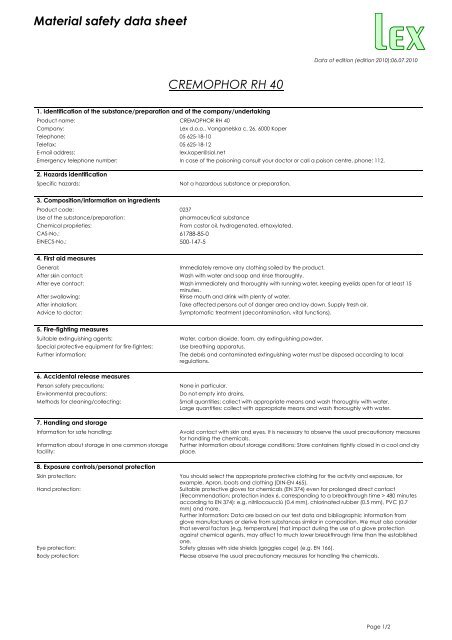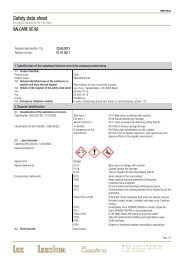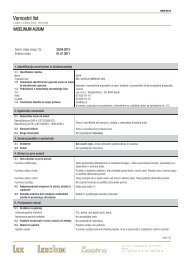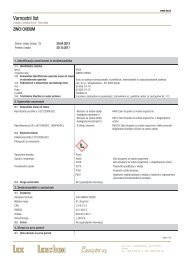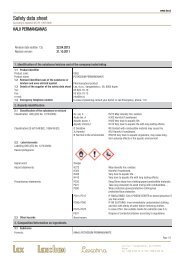Material safety data sheet CREMOPHOR RH 40 - Lex doo
Material safety data sheet CREMOPHOR RH 40 - Lex doo
Material safety data sheet CREMOPHOR RH 40 - Lex doo
Create successful ePaper yourself
Turn your PDF publications into a flip-book with our unique Google optimized e-Paper software.
<strong>Material</strong> <strong>safety</strong> <strong>data</strong> <strong>sheet</strong><br />
Data of edition (edition 2010):06.07.2010<br />
<strong>CREMOPHOR</strong> <strong>RH</strong> <strong>40</strong><br />
1. Identification of the substance/preparation and of the company/undertaking<br />
Product name: <strong>CREMOPHOR</strong> <strong>RH</strong> <strong>40</strong><br />
Company:<br />
<strong>Lex</strong> d.o.o., Vanganelska c. 26, 6000 Koper<br />
Telephone: 05 625-18-10<br />
Telefax: 05 625-18-12<br />
E-mail address:<br />
lex.koper@siol.net<br />
Emergency telephone number: In case of the poisoning consult your doctor or call a poison centre, phone: 112.<br />
2. Hazards identification<br />
Specific hazards:<br />
Not a hazardous substance or preparation.<br />
3. Composition/information on ingredients<br />
Product code: 0237<br />
Use of the substance/preparation:<br />
pharmaceutical substance<br />
Chemical proprieties:<br />
From castor oil, hydrogenated, ethoxylated.<br />
CAS-No.: 61788-85-0<br />
EINECS-No.: 500-147-5<br />
4. First aid measures<br />
General:<br />
After skin contact:<br />
Immediately remove any clothing soiled by the product.<br />
Wash with water and soap and rinse thoroughly.<br />
After eye contact: Wash immediately and thoroughly with running water, keeping eyelids open for at least 15<br />
minutes.<br />
After swallowing:<br />
Rinse mouth and drink with plenty of water.<br />
After inhalation:<br />
Advice to doctor:<br />
Take affected persons out of danger area and lay down. Supply fresh air.<br />
Symptomatic treatment (decontamination, vital functions).<br />
5. Fire-fighting measures<br />
Suitable extinguishing agents:<br />
Special protective equipment for fire-fighters:<br />
Further information:<br />
6. Accidental release measures<br />
Person <strong>safety</strong> precautions:<br />
Environmental precautions:<br />
Methods for cleaning/collecting:<br />
7. Handling and storage<br />
Information for safe handling:<br />
Information about storage in one common storage<br />
facility:<br />
Water, carbon dioxide, foam, dry extinguishing powder.<br />
Use breathing apparatus.<br />
The debris and contaminated extinguishing water must be disposed according to local<br />
regulations.<br />
None in particular.<br />
Do not empty into drains.<br />
Small quantities: collect with appropriate means and wash thoroughly with water.<br />
Large quantities: collect with appropriate means and wash thoroughly with water.<br />
Avoid contact with skin and eyes. It is necessary to observe the usual precautionary measures<br />
for handling the chemicals.<br />
Further information about storage conditions: Store containers tightly closed in a cool and dry<br />
place.<br />
8. Exposure controls/personal protection<br />
Skin protection:<br />
You should select the appropriate protective clothing for the activity and exposure, for<br />
example. Apron, boots and clothing (DIN-EN 465).<br />
Hand protection:<br />
Suitable protective gloves for chemicals (EN 374) even for prolonged direct contact<br />
(Recommendation: protection index 6, corresponding to a breakthrough time > 480 minutes<br />
according to EN 374): e.g. nitrilocaucciù (0.4 mm), chlorinated rubber (0.5 mm), PVC (0.7<br />
mm) and more.<br />
Further information: Data are based on our test <strong>data</strong> and bibliographic information from<br />
glove manufacturers or derive from substances similar in composition. We must also consider<br />
that several factors (e.g. temperature) that impact during the use of a glove protection<br />
against chemical agents, may affect to much lower breakthrough time than the established<br />
one.<br />
Eye protection: Safety glasses with side shields (goggles cage) (e.g. EN 166).<br />
Body protection:<br />
Please observe the usual precautionary measures for handling the chemicals.<br />
Page 1/2
9. Physical and chemical properties<br />
Form:<br />
past<br />
Colour:<br />
white to yellowish<br />
Odour:<br />
almost odourless<br />
pH value: (20 °C, 100 g/l) 6,0 – 7,0<br />
Melting point: 16-26 °C<br />
Flesh point: 242 °C<br />
Auto-ignition temperature: 375 °C<br />
Density: (60 °C) 1,03 kg/cm 3<br />
Solubility in water: (23 °C) > 490 g/l<br />
Solubility in solvents:<br />
Soluble in organic solvents.<br />
Coefficient n-octanol/water (log Pow): -0,76<br />
Viscosity (dynamic): (60 °C) 176 mPa.s<br />
10. Stability and reactivity<br />
Thermal decomposition: 300 °C<br />
Reactions to avoid:<br />
There are no known hazardous reactions if substance is used and stored appropriately.<br />
Hazardous decomposition products:<br />
There are no known hazardous decomposition products.<br />
11. Toxicological information<br />
Irritation:<br />
Sensitization:<br />
Acute toxicity:<br />
Mutagenicity:<br />
Eyes: not irritant (rabbit).<br />
Skin: not irritant (rabbit).<br />
Not sensitizing.<br />
Oral: LD-50: > 20000 mg/kg (rat)<br />
Inhalat.: LC-50: > 2,06 mg/kg (rat), 4 h<br />
Inhalation risk test (IRT): inhalation of a vapour-air mixture has not a highly saturated acute risk<br />
(no mortality within 8 hours).<br />
There was no mutagenic effect in various experiments on bacteria and in on most<br />
mammalian cell cultures that were examined. Even in experiments on animals was no<br />
mutagenic effect. Animal tests have shown no fetal damage.<br />
12. Ecological information<br />
Use product with good working habits and do not allow it, to reach ground water, water course or sewage system.<br />
Persistence and degradability:<br />
BOD (ThOD): 80 -90 % (28 days) - readily biodegradable.<br />
Eco-toxicity: LC50: Oryzias latipes: > 10000 mg / l (48 h)<br />
The test was performed above the maximum solubility. Signs of toxic action are refered to the<br />
nominal concentration.<br />
EC50: Desmodesmus subspicatus: > 100 mg/l (72 h)<br />
Microorganisms / Effect on activated sludge:<br />
EC50: active sludge: > 700 mg (0.5 h / l),<br />
Probably the product is not harmful to aquatic organisms.<br />
The correct placing of low concentrations in biological treatment plant should not affect the<br />
activity of degradation of activated sludge.<br />
13. Disposal considerations<br />
Follow with local officials. Recover if possible. Send to authorized disposal plants or for incineration under controlled conditions. Operate according to<br />
existing local and national regulations.<br />
The unclean packaging must be disposed of as the product.<br />
14. Transport information<br />
Not classified as dangerous in the meaning of transport regulations.<br />
15. Regulatory information<br />
Legislation:<br />
• Official gazette RS, nr. 110/2003, 47/2004)<br />
• Official gazette RS, nr. 35/2005)<br />
• Official gazette RS, nr. 67/2005)<br />
• Official gazette RS, nr. 84/1998, 45/2000, 20/2001, 13/2003, 41/2004)<br />
• Official gazette RS, nr. 104/2000, 12/2002,41/2004)<br />
• Official gazette RS, nr. 9/2003, 66/2003)<br />
• Official gazette RS, nr. 100/2001)<br />
16. Other information<br />
NIOSH -Registry of toxic effects of chemicals substances ( 1983)<br />
I.N.R.S. -Fiche toxicologique<br />
CESIO -Classification and labelling of anionic, nonionic surfactants ( 1990 )<br />
This version replaces all previous versions.<br />
Page 2/2


